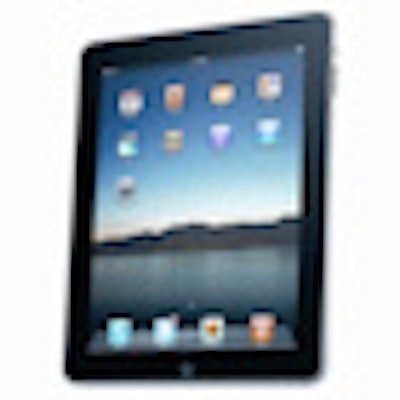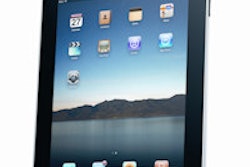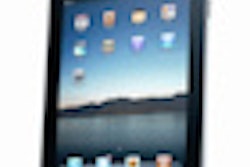
Dentists are singing the praises of Apple's iPad, citing its wide range of uses from charting, displaying x-rays, and managing dental records to improving diagnoses and educating their patients.
Mark Burhenne, D.D.S., of Sunnyvale, CA, who extols the device's versatility on his website, askthedentist.com, said the iPad is useful from the minute patients walk into his office until they leave.
“Patients see it as improving their whole healthcare experience.”
— Mark Burhenne, D.D.S.
"It was an immediate hit; patients just love it," he said. "They can play Scrabble, read Winnie the Pooh, watch the latest Netflix movie, or check their e-mail and Facebook."
Although Dr. Burhenne finds it particularly useful for taking and displaying digital radiographs, he said in his office the waiting room is where the iPad is so far most popular. Besides the "cool" factor, Apple's latest gadget provides unlimited educational value for patients, he added, allowing them to take interactive quizzes, watch videos, or read articles about dental care as they wait.
"It's entertaining and informative and so much better than handing them a magazine," he told DrBicuspid.com. "Patients see it as improving their whole healthcare experience."
Highlights problem areas
Once patients are in the chair, Dr. Burhenne likes iPad's ability to serve as a conduit for taking and displaying x-rays. Besides showing patients problem areas on their x-rays, he can also expand, modify, or send the images.
"If a patient has a cavity or a root canal, I can hand her the iPad and she can zoom in and examine the issue herself and then e-mail it to herself so she can keep it for her personal online health records," he explained. "Along with exposing my patients to less radiation, the iPad will provide a more precise x-ray image to make diagnoses even more accurate."
 Mark Burhenne, D.D.S., uses his iPad to show patients digital radiographs of their teeth. Image courtesy of Dr. Mark Burhenne.
Mark Burhenne, D.D.S., uses his iPad to show patients digital radiographs of their teeth. Image courtesy of Dr. Mark Burhenne.
The iPad design also makes it much more convenient and sanitary than laptops to use with patients. "Laptops are a white elephant in an operatory," Dr. Burhenne said. "You can spill things on them and you can't clean them. With an iPad you just put a Ziploc bag over it. Getting rid of a keyboard made a huge difference for asepsis concerns."
Being able to access to online health records is another attractive feature.
"As the iPad propagates itself throughout the medical community, there will come a day when I can place the iPad in the hands of a patient and ask them to log in to their records," Dr. Burhenne said. "I will be able to look at an x-ray of the patient's tooth from a dentist in another part of the country."
Guru animation
John Flucke, D.D.S., who writes and blogs regularly about dental technologies, uses Guru animated educational software on his iPad to help explain needed work to his patients.
|
iPad specs The iPad weighs just 1.5 lb, much less than most conventional laptops. And its vital statistics compare favorably to the previous Apple mobile platform of choice, the iPhone. The iPad's 9.7-inch display provides 1024 x 768-pixel resolution at 132 pixels per inch (PPI), while the iPhone 4 has a 3.5-inch (diagonal) display with a resolution of 640 x 960, although the iPhone sports 326 PPI. The larger display allows images to be displayed at or closer to their native resolution than they would on smaller portable devices. The battery life of the iPad is also an advantage over the iPhone; users have reported using the iPad for two busy days of eight-hour use without having to recharge. |
"It shows the most common dental procedures, and I can draw images with my finger on the screen to illustrate what I'm going to do, so it's very nice for consultations," he told DrBicuspid.com. "It becomes a lot less threatening because it looks a lot more like Shrek and less like surgery."
Dr. Flucke also likes having digital access to Lexi-Comp's medical software, which is updated daily. It includes a drug database, information on how to handle dental emergencies, and pathology textbooks on hard- and soft-tissue diseases.
"Knowing I can just reach into my pocket and pull out 13 textbooks' worth of information whenever I need it is invaluable," he said. "One of the things I have with me all the time is my iPod Touch, and if it's not there I feel like I'm not wearing my wedding ring. I rely on it several times a day."
Dr. Burhenne believes the iPad will enable dentists to have truly paperless offices. "It's the last piece of the puzzle," he said.
He envisions a day when patients will be handed the device when they first walk in, and it will show them their file, what procedures are scheduled for that visit, the cost, and allow them to ask questions in advance. At the end of the visit, the iPad can help with billing, provide detailed explanations of services rendered and why, and then patients can use it to charge their credit cards. "It walks them through the whole process," Dr. Burhenne said.
The device is handy for alerting patients about any traffic problems as they leave the office. It also serves as a convenient internal marketing tool; for example, letting patients know if the dentist is running specials on teeth-whitening services. It also offers the potential for delivering interactive, rich 3D content directly into the hands of a surgeon or other referring physicians.
And because information is stored via cloud computing, it eliminates security issues of having data stored on laptop hard drives. For example, sometimes patients forget to log out of their Facebook or e-mail accounts when they leave his office, Dr. Burhenne noted. In these cases, "we reset the cache so the information isn't stored out of privacy and HIPAA [Health Insurance Portability and Accountability Act] concerns," he said. "Patients can hack into laptops; you'd be surprised."
Multiple apps emerging
Among the many dental applications already available for the iPad is the DDS GP from Demo Dental Suite. It features illustrations of more than 160 dental diagnoses and procedures, and can also be used with the iPhone and iPod Touch.
MacPractice now offers iPad integration software that allows dentists to use MacPractice DDS, DR, and EDR (electronic dental record) on the iPad. In addition to qualifying its MacPractice iPhone Interface for use on the iPad, the new iPad Interface makes the functionality of MacPractice DDS available on the iPad.
Full access to the MacPractice DDS system from anywhere with an Internet connection makes it possible to view and update patient charts from home, a satellite office, or elsewhere. And through a collaboration with Aqua Connect, MacPractice for iPad allows multiple doctors to access the MacPractice system on a single machine at the same time, with local sound and audio support and built-in encryption that satisfies HIPAA guidelines.
And Miami Beach, FL, dentist Jared Plitt, D.M.D., has designed Cosmetic Dentistry Calculator, a cosmetic dentistry application that can be used with the iPod Touch, iPad, and iPhone. The calculator provides a starting point for aesthetic case planning and is a useful diagnostic tool that can be used chairside during patient consultations, according to Dr. Plitt.
Looking ahead, Dr. Flucke would like to see an application that would allow him to read cone-beam CTs on his iPad.
He and Dr. Burhenne, both avowed iPad aficionados, admit they joined millions of other Apple lovers who couldn't wait to get their hands on the popular devices as soon as they hit the stores earlier this year.
"We're blind followers," Dr. Burhenne admitted. "When Steve Jobs says you need it, we buy it."
Copyright © 2010 DrBicuspid.com



















